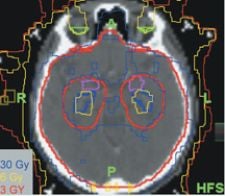
cIso-dose lines for whole brain treatment plan using helical TomoTherapy. A buffer zone of ~ 1cm around the hippocampus (red lines) with a lower dose is needed in order to keep the dose to the hippocampus as low as possible.
The University of Wisconsin Hospitals and Clinics in Madison, WI, is at the forefront of medical research and technology, so it makes sense that the first prototype image-guided IMRT system produced by TomoTherapy Inc. was installed in the same university where the research began over 15 years ago.
Minesh Mehta, M.D., UW professor of Human Oncology, has been a TomoTherapy user since 2001. He has overseen the transition from the world’s first clinical TomoTherapy research system to the upgrade of a production Hi·Art System in 2004.
Recently, the department decided to add a second TomoTherapy Hi·Art System. “Recent upgrades have made the system more robust, so we decided to expand our technology offering,” said Dr. Mehta. “We also decided to purchase a second system because of the IG/IMRT capabilities.”
In addition to treating a wide range of cases, TomoTherapy’s helical, image-guided IMRT allows for treatment of the most complex cases efficiently and effectively at the UWHC. Low-intensity MVCT imaging before each treatment allows for precise, confident dose delivery. The Hi·Art System can efficiently treat multiple lesions during one treatment at a rate up to 850cGy per minute, while the treatment length is 40 cm by 1.6 meters, allowing for head-to-toe delivery in cases such as craniospinal and total body irradiation. In addition, the TomoTherapy Planned Adaptive software allows Dr. Mehta and his staff to analyze and modify patient plans at any point during the treatment course. This is especially useful when patients lose weight or as treatment areas change, so the contours and structures can be adjusted to fit the plan and optimize treatment dose to the tumor, while sparing healthy tissue.
In particular, Dr. Mehta and his team are looking at ways the technology can help his patients with brain cancer. “Linac-based brain tumor plans can be comparable to TomoTherapy plans, but the difference lies in the delivery of radiation,” said Dr. Mehta. “The Hi·Art System can easily generate plans, efficiently deliver treatment and increase throughput at the clinic.”
Dr. Mehta added that his brain tumor patients benefit from the conformal avoidance that the Hi·Art System allows. Conformal avoidance is used in cases where the tumor boundary cannot be easily defined. Rather than trying to map the precise area to be treated, clinicians instead map out critical structures that must be avoided. “Helical delivery allows for superior dose conformance and critical structure avoidance. The TomoTherapy unit is capable of delivering helical fan-beam IMRT projected through 51 beam angles.”
Dr. Mehta and Deepak Kuntia, M.D., along with Hazim Jaradat, Ph.D., are pioneering optimal conformal avoidance to critical structures in the brain. Specifically, they are developing TomoTherapy treatment plans to conformally avoid the hippocampus, the structure that houses memory function in the brain. Dr. Mehta not only wants to eliminate his patients’ cancer, he wants to preserve their quality of life for the future, sparing patients’ memory, speech, vision and hearing as much as possible. He believes that conformal avoidance with helical IMRT can do just that.


 November 12, 2025
November 12, 2025 









